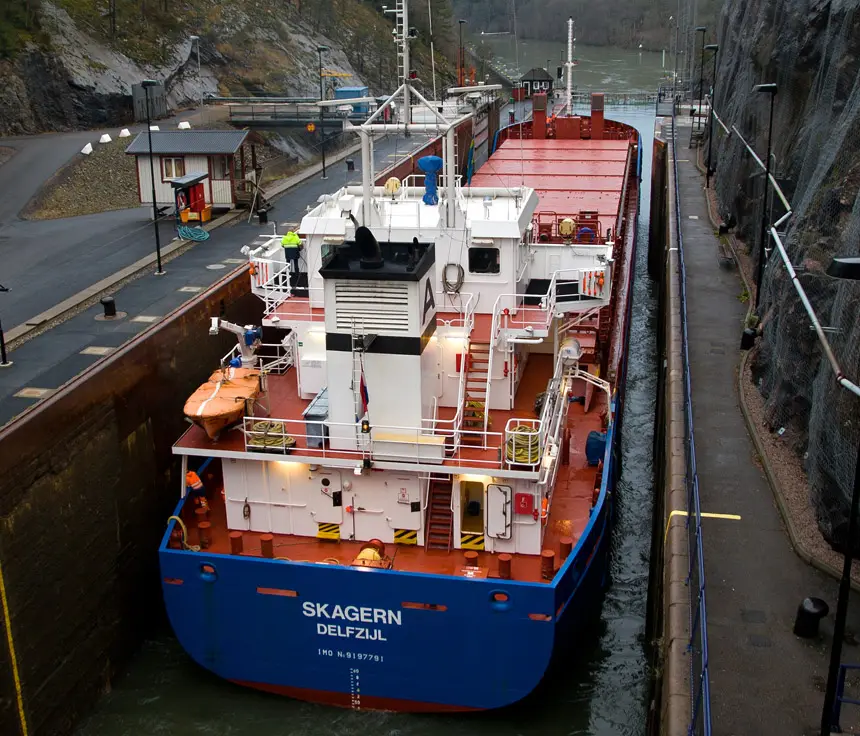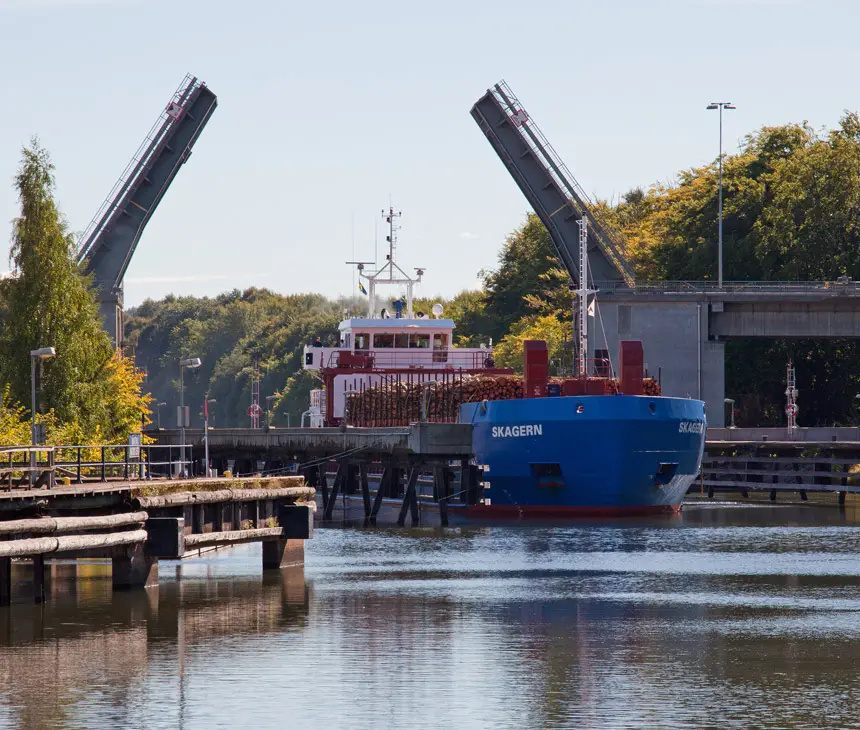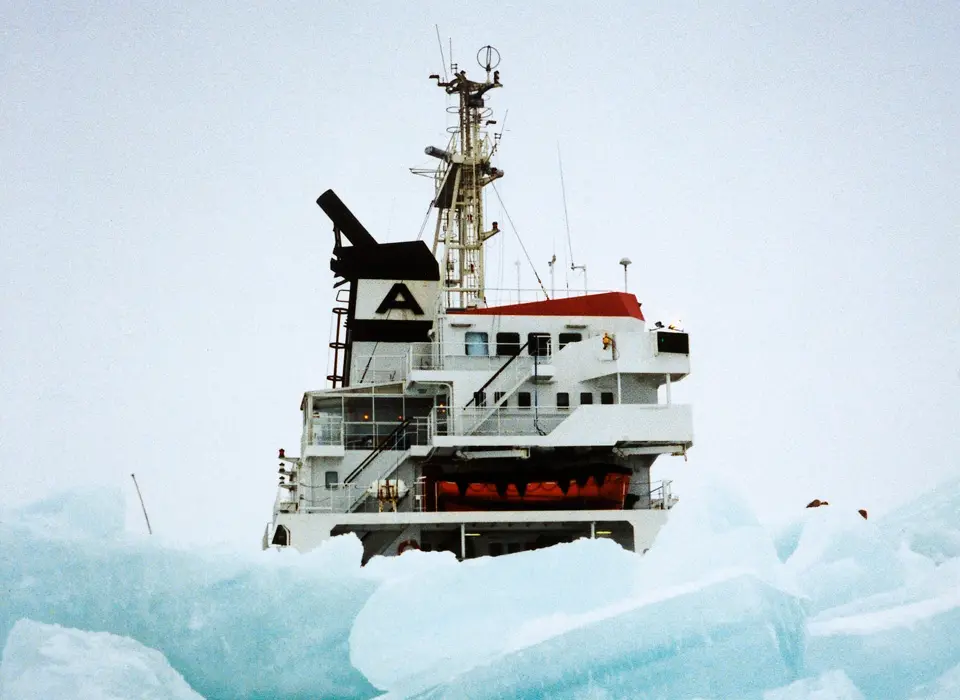History
Spanning more than 175 years and two World Wars, through economic booms and market crashes, from the steam boiler to cloud services, Ahlmark’s history covers nearly the entire era of industrialization. Here are a few of our milestones.
1847 - 1855
The 26-year-old Oscar Ferdinand Ahlmark moves to Karlstad. In 1847, he receives permission to operate business in commerce, commission, forwarding and insurance in Karlstad. By taking over an existing business, he gets the premises he needs. The “Salt Square” location (now “Residence Square”) was also advantageous for transports over the Port of Karlstad. O. F. Ahlmark decides to invest in shipping and becomes ship’s husband for the steamer Uddeholm.
Ahlmark started operations during an upward swing in shipping, due largely to the construction of the Trollhätte Canal (locks) in 1800 and the Göta Canal in 1832.
1861 - 1889
Ahlmark actively contributes to the construction of the Inner Harbour in 1861 and becomes the first Chairman of the Port of Karlstad Board of Directors.
In 1872, two steamers are built on Karlstad Wharf. O. F. Ahlmark dies the following year. To honour his memory, one of the steamers is christened the O F Ahlmark. His nephew, Karl August Ahlmark, takes over the business and runs it along with Gustaf Sjöstedt.
The steamships Karlstad and Forshaga are built to meet iron and timber transport needs. Ahlmark manages the companies established to finance the two ships.
Gustaf Sjöstedt dies in 1889 and Karl August Ahlmark, now sole owner, changes the name of the company to O. F. Ahlmark & Co Eftr.
1901 - 1916
Karl August Ahlmark dies in 1901 and the business is transferred to August Uppvall, former captain of the Karlstad and the Forshaga. After Uppvall’s death in 1909, the dynamic and visionary Josef Bergendorff joins the company.
One of the most important years in Ahlmark’s history is 1916, when the new Trollhätte Canal was inaugurated. The canal enables a direct freight connection with the North Sea for vessels up to 2,000 tonnes deadweight. Bergendorff recognizes the importance of the canal for Ahlmark’s future in shipping, and direct imports to the Vänern ports now enable the expansion of the coal division.
1917 - 1920
In 1917, Ahlmark is converted into a limited company and the companies that owned the canal steamers Karlstad and Forshaga are merged into the Ångfartygs Aktiebolag Karlstad company. In addition, Karlstad Shipyard is built on the 1.5 ha of new land on Kanikenäset. The first steps are now taken toward more liner-oriented service and shipping company Stjärnan is formed by a number of stakeholders. A branch office is also opened in Kristinehamn.
In 1918, Ångfartygs Aktiebolag Karlstad changes its name to Värmlands Rederiaktiebolag, with Josef Bergendorff as ship’s husband. Bergendorff dies in 1920, but under his leadership, the company has gained a solid foundation for future expansion.
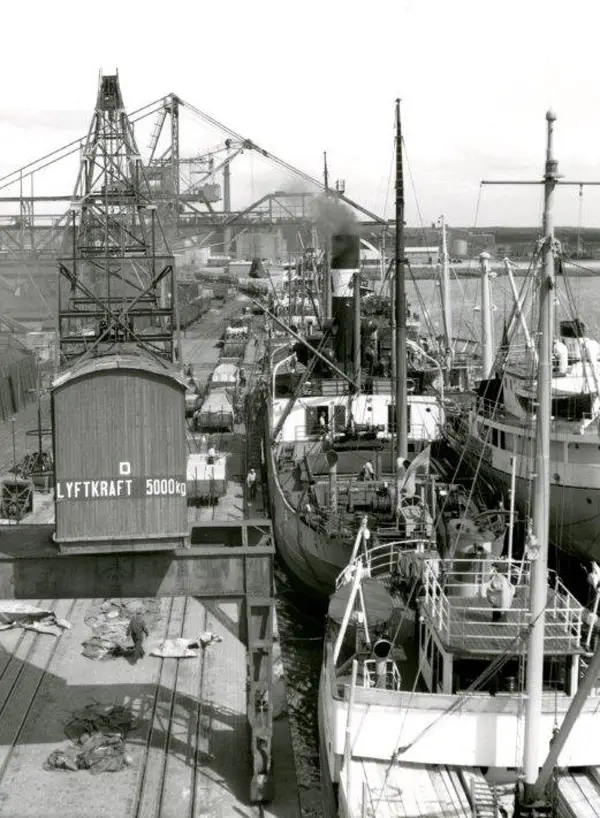
1921 - 1930
The company is now bought by Bror Pettersson and Gustaf Hemmingson. Ahlmark establishes itself as a shipowner by purchasing a fleet of North Sea vessels between 1929 and 1939: the Gapern, the Alstern, the Visten, the Saxen, the Mangen and the Foxen.
In 1921, all Stjärnan boats are in freight service between Lake Vänern and England, Germany, Holland, Belgium and France. Imports of coal and coke grow rapidly and large facilities are built in Karlstad and Kristinehamn for storing coal and coke, as well as crushing and sorting plants. The distribution system to industry and retailers in the Vänern region is expanded.
1937 - 1945
Rederi AB Stjärnan is now owned by Ahlmarks. At the end of the thirties, Ahlmarks, with its 15 vessels totaling 20,000 deadweight tons, is one of Sweden's more important shipping companies.
After the German occupation of Norway in 1940, the way west is blocked. Transportation across the North Sea is dangerous and Ahlmarks loses 28 men and the vessels Foxen, Mangen, Aspen and Gapern. The supply of coal and coke becomes increasingly scarce and Ahlmarks plays a significant role in the supply and distribution of substitute fuels, including firewood. In 1945, Ahlmarks renews its fleet, including the Aspen II, which becomes the company's first shelter-deck vessel.
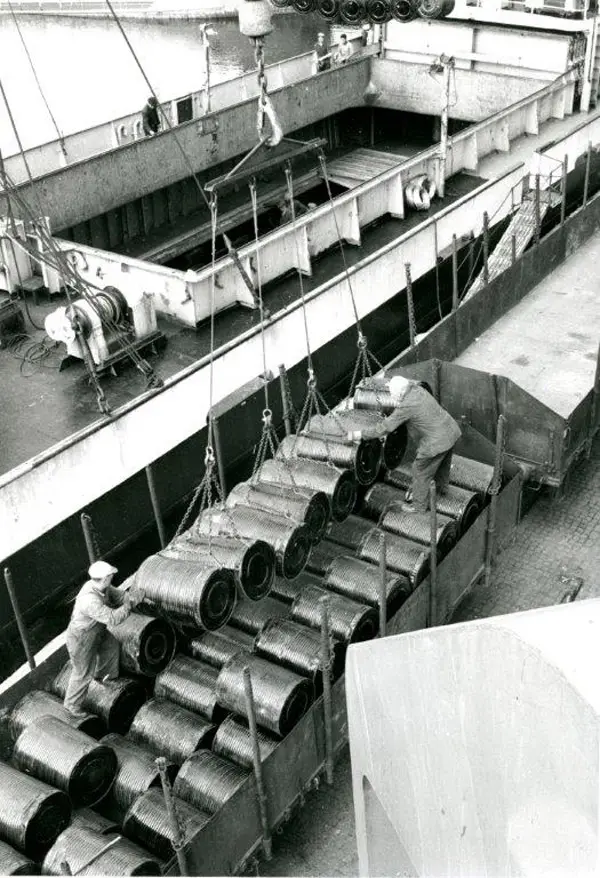
1948 - 1955
A new maritime law is coming into force, which means that manning costs are increasing dramatically. It is also becoming increasingly difficult to operate vessels under the Swedish flag. By investing in so-called paragraph boats, it is possible to meet the increased costs to some extent. This is due to the special design of the vessels, which results in lower tonnage and thus a relaxation of the staffing regulations.
The company’s coal division continues to perform well. The independent companies Karlstads Kolimport, Bränsleaffären and Värmlands Kol och Koks sell mainly to properties and 150 distributors focus on households. The distribution facilities for coal and coke in Karlstad and Kristinehamn are modernized.
In 1950, Ahlmark enters a partnership with Stora Kopparberg’s and Transatlantic’s oil company Koppartrans for the distribution of oil, diesel and petrol.
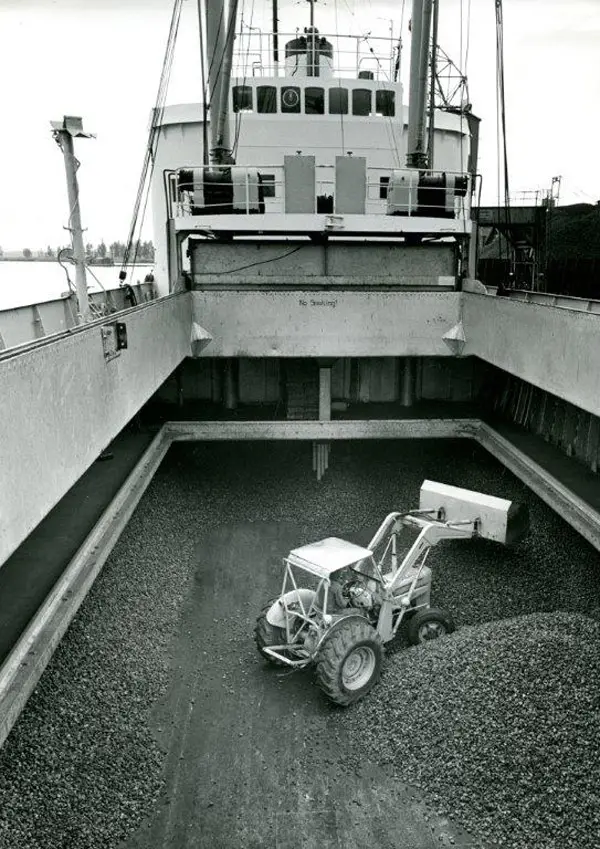
1955 - 1966
The steamers Karlstad and Forshaga are decommissioned in 1955 and an interesting era is over. For a several years, Ahlmark had offices at several locations in Karlstad. To concentrate operations, a seven-storey commercial building is constructed in 1958 in the Tapiren quarter of central Karlstad. The building is later supplemented with Karlstad’s first parking garage.
Ahlmark–Koppartrans changes its name in 1963 to Ahlmarks Bränsle AB. The company retains its strong local position in the 1960s and 70s.
Oil depots are built in Karlstad, Kristinehamn and Åmål. Later, offices and distribution centres are added in Örebro and Göteborg. In 1966, a cargo dock is added to the outer harbour, largely due to the participation of Ahlmark.
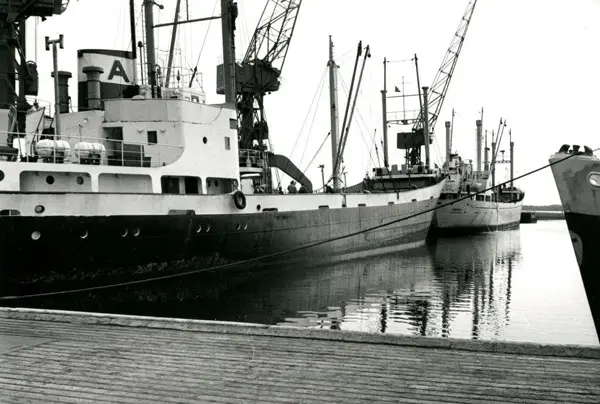
1971 - 1972
Ahlmark’s first fully open vessels for vertical cargo handling, the Alstern and the Gapern, are delivered from a Norwegian shipyard. For the first time, the crew is adapted to the ship’s equipment instead of the registered tonnage, resulting in a crew of 10 instead of 16. With these vessels, Ahlmark becomes a pioneer in Swedish shipping.
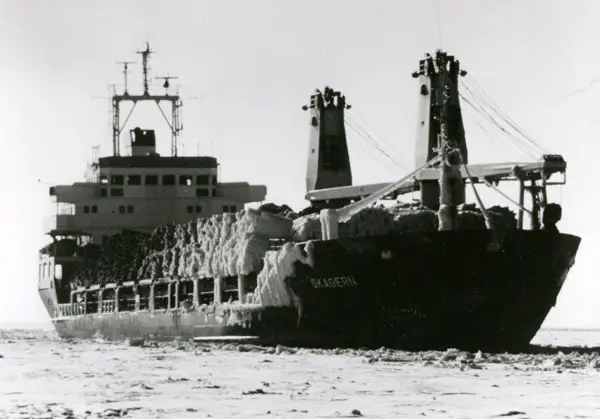
1975 - 1981
In 1975, Ahlmark acquired AB Byggbeslag, a company active in the locks and architectural hardware industry. The company develops well under the direction of Ahlmark and reaches the market-leading position it still holds today.
Liner service from the Norrland coast are established in 1976-1977 and the new vessel Visten is delivered. In 1981, investment company Wermia AB was formed, with Ahlmarks as one of the stakeholders. The M/S Barken is purchased in 1982, which with its 10,000 deadweight tonnage, it becomes the company’s largest vessel.
1983 - 1989
The shipping company continues to expand outside Lake Vänern. Two 6,000-tonne vessels, the Skagern and the Sommen, are delivered for Norrland service. Two new vessels, the Unden and the Mangen, enter service on Lake Vänern, offering powerful machinery, which have a very good ability to push through ice.
In 1987, Wermia AB steps in as co-owner of Byggbeslag/Landol. The strong world economy leads to gradual improvements on the shipping market. The Alstern and the Noren, sister vessels to the Skagern and the Sommen, are purchased in 1988 and 1989. This is part of Ahlmark’s efforts to build up a first-class proprietary fleet for Norrland service.
1990 - 1992
O.F. Ahlmarks’ operations now includes shipping, property management and fuel operations. In the spring of 1991, Ahlmarks’ ownership in Wermia AB increases to over 50%. At this point, the other owners sell to Ahlmarks, so Wermia becomes a wholly owned subsidiary of Ahlmark.
Ahlmarks develops a new transport concept for Norrland service. In 1991, a number of specially designed vessels are purchased from Germany for this traffic. Due to the merger of the German states and the resulting economic turbulence, the German shipyard is unable to fulfill its commitments.
Heavy investments in 1992 means heavy interest costs. To ease this burden of debt, Ahlmarks Bränsle is sold to Swedish Shell.
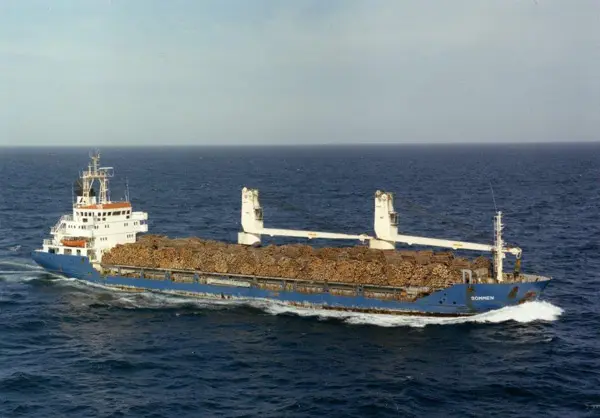
1993 - 1997
The result improved considerably in 1993, one of the reasons being the settlement with the German shipyard, which provides the shipping company with considerable compensation. Operations continue to go very well.
Wernia’s performance increasingly improves and this positive development continues in 1994 for all companies. The shipping company achieved its best results ever, as did the group as a whole.
During the year, Kristinehamns Terminal AB and Karlstads Stuveri AB are transferred to the newly formed Vänerhamn AB. Ahlmarks becomes the largest shareholder, with approximately 27% of holdings.
In 1996, three combination vessels are acquired, the Fryken, the Saxen and the Visten, which are unique in that they can take forest products one way and oil in return.

1998 –
The Group continues to expand organically but also with complementary acquisitions within the existing business areas.
As a consequence of the agreement between the Swedish government and Vänern stakeholders, the associated company Vänerhamn AB sells to the municipalities.
The Group structure is gradually streamlined and a consolidation yields positive results on the balance sheet.
The Group now has SEK 3 billion in annual revenue and employs over 1,500 people in eight countries.
The foundations have been laid for continued expansion with good prospects for the future.
